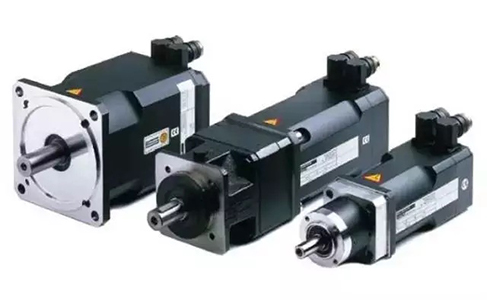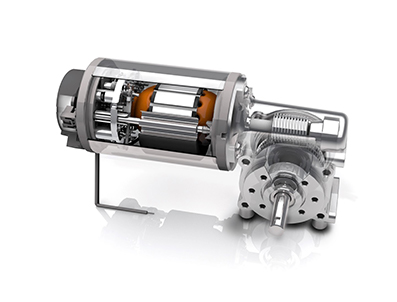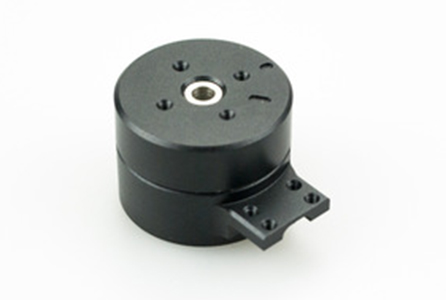Servo motors are micro motors used as actuators in automatic control devices. Their function is to convert electrical signals into angular displacement or angular velocity of the shaft. Servo motor, also known as executive motor, is used as an actuator in an automatic control system. It converts the received electrical signal into angular displacement or angular velocity output on the motor shaft. "Servo motor" can be understood as a motor that absolutely obeys the control signal: before the control signal is sent, the rotor is stationary; when the control signal is sent, the rotor immediately rotates; when the control signal disappears, the rotor can stop immediately.

Classification of Servo motor
Servo motors are divided into two categories: AC servo and DC servo. The basic structure of an AC servo motor is similar to that of an AC induction motor (asynchronous motor). There are two field windings Wf and control winding WcoWf with phase space displacement of 90° electrical angle on the stator. When connected to a constant AC voltage, the AC voltage or phase change applied to Wc is used to control the operation of the motor. AC servo motors have the characteristics of stable operation, good controllability, fast response, high sensitivity, and strict non-linearity indexes of mechanical characteristics and adjustment characteristics (requirements less than 10% to 15% and less than 15% to 25%, respectively).
Advantages and disadvantages of DC servo motors
Advantages: The speed control is very accurate, the torque and speed characteristics are very hard, the control principle is simple, easy to use, and cheap;Disadvantages: brush commutation, speed limit, additional resistance, and wear particles (not suitable for dust-free and explosive environments).
The basic structure of a DC servo motor is similar to that of a general DC motor. Motor speed n=E/K1j=(Ua-IaRa)/K1j, where E is the armature back electromotive force, K is a constant, j is the magnetic flux per pole, Ua and Ia are the armature voltage and armature current, and Ra is Armature resistance, changing Ua or changing φ, can control the speed of the DC servo motor, but generally the method of controlling the armature voltage is adopted. In the permanent magnet DC servo motor, the field winding is replaced by a permanent magnet, and the magnetic flux φ is constant. . The DC servo motor has good linear regulation characteristics and fast time response.
Advantages and disadvantages of AC servo motors
Advantages: The characteristics of speed control are good, smooth control can be realized in the entire speed zone, almost no oscillation, high efficiency of more than 90%, low heat generation, high-speed control, high-precision position control (depending on the encoder accuracy), rated operation In the area, it can achieve constant torque, low inertia, low noise, no brush wear, and maintenance-free (suitable for dust-free and explosive environments);Disadvantages: The control is more complicated, the driver parameters need to be adjusted on-site to determine the PID parameters, and more connections are required.
DC servo motors are divided into brush and brushless motors. Brushed motors have low cost, simple structure, large starting torque, wide speed range, easy control; maintenance is required, but easy to maintain (change carbon brushes), generate electromagnetic interference, have requirements for the use environment, and are generally used in cost Sensitive general industrial and civil occasions.
The brushless motor is small in size, light in weight, large in output, fast in response, high in speed, small inertia, stable torque and smooth rotation, complex control, intelligent, flexible electronic commutation, can commutate with square wave or sine wave, the motor is maintenance-free, high efficiency and energy saving , The electromagnetic radiation is small, the temperature rise is low, and the life is long, so it is suitable for various environments.
AC servo motors are so-called brushless motors. They are divided into synchronous and asynchronous motors. At present, we generally use synchronous motors in motion control because of their large power range, large power, large inertia, low maximum speed, and low speed. Decrease at a uniform speed with increasing power, suitable for low-speed and stable operation occasions.
The rotor inside the servo motor is a permanent magnet. The driver controls U/V/W three-phase electricity to form an electromagnetic field. The rotor rotates under the action of this magnetic field. At the same time, the motor’s built-in encoder transmits the feedback signal to the driver. Finally, the feedback value It will be compared with the target value to adjust the angle of rotor rotation. The accuracy of the servo motor is determined by the accuracy of the encoder (number of lines).
Q: What is the difference in performance between AC servo motors and brushless DC servo motors?
A: The performance of AC servo motor is better, because AC servo is controlled by sine wave and the torque ripple is small; while brushless DC servo is controlled by trapezoid wave. But brushless DC servo control is relatively simple and cheap.
The rapid development of permanent magnet AC servo drive technology makes the DC servo system face the crisis of being eliminated[/p][p=30,2,left]Since the 1980s, with integrated circuits, power electronics technology and AC and With the development of variable speed drive technology, permanent magnet AC servo drive technology has made outstanding development. Famous electrical manufacturers in various countries have successively introduced new AC servo motors and servo drive series products. The AC servo system has become the main development direction of the contemporary high-performance servo system, making the DC servo system face the crisis of being eliminated.
Compared with DC servo motors, permanent magnet AC servo motors mainly have the following five advantages:

Principle of Servo Motor
The structure of the AC servo motor stator is basically similar to the capacitor split-phase single-phase asynchronous motor. The stator is equipped with two windings with a position difference of 90°, one is the excitation winding Rf, which is always connected to the AC voltage Uf; the other is the control winding L, which is connected to the control signal voltage Uc. Therefore, AC servo motors are also called two servo motors.
The rotor of an AC servo motor is usually made of a squirrel cage, but in order to make the servo motor have a wider speed range and linear mechanical characteristics, there is no "rotation" phenomenon and fast response performance. Compared with ordinary motors, it should have the two characteristics of large rotor resistance and small moment of inertia. At present, there are two types of rotor structures that are widely used: one is a squirrel cage rotor made of high-resistivity conductive materials with high-resistivity conductive materials. In order to reduce the rotor's moment of inertia, the rotor is made slender; One is a hollow cup-shaped rotor made of aluminum alloy. The cup wall is only 0.2-0.3mm. The hollow cup-shaped rotor has a small moment of inertia, quick response, and stable operation, so it is widely used.
Without the control voltage, there is only the pulsating magnetic field generated by the excitation winding in the stator of the AC servo motor, and the rotor is stationary. When there is a control voltage, a rotating magnetic field is generated in the stator, and the rotor rotates in the direction of the rotating magnetic field. When the load is constant, the motor speed changes with the control voltage. When the phase of the control voltage is opposite, the servo motor Will be reversed.
Although the working principle of an AC servo motor is similar to that of a capacitor-operated single-phase asynchronous motor, the rotor resistance of the former is much larger than that of the latter. Therefore, compared with a capacitor-operated asynchronous motor, the servo motor has three notable features:
Precision transmission micro motor
"Precision transmission micro motor" can quickly and correctly execute instructions which is frequently changing in the system, drive the servo mechanism to complete the work required by the instructions, and most of them can meet the following requirements:
The types and structures of precision transmission micromotors, and the performance comparison are as follows:
AC servo motor
(1) Cage two-phase AC servo motor (slender cage rotor, approximate linear mechanical characteristics, small volume and excitation current, low-power servo, low-speed operation is not smooth enough).
(2) Non-magnetic cup-shaped rotor two-phase AC servo motor (hollow cup rotor, mechanical characteristics are approximately linear, large volume and excitation current, low-power servo, smooth low-speed operation).
(3) Two-phase AC servo motor with ferromagnetic cup rotor (cup rotor with ferromagnetic material, approximate linear mechanical characteristics, large rotor inertia, small cogging effect, stable operation).
(4) Synchronous permanent magnet AC servo motor (consisting of permanent magnet synchronous motor, tachometer and position detection element coaxial integrated unit, the stator is 3-phase or 2-phase, the magnetic material rotor must be equipped with a driver; wide speed range, mechanical The characteristics are composed of constant torque zone and constant power zone, which can be continuously locked, fast response performance is good, output power is large, torque fluctuation is small; there are two methods of square wave drive and sine wave drive, with good control performance, it is an electromechanical integration Chemical products).
(5) Asynchronous three-phase AC servo motor (the rotor is similar to the cage asynchronous motor, it must be equipped with a driver, which uses vector control, which expands the range of constant power speed control, and is mostly used in machine tool spindle speed control systems).
AC servo motor
(1) Cage two-phase AC servo motor (slender cage rotor, approximate linear mechanical characteristics, small volume and excitation current, low-power servo, low-speed operation is not smooth enough).
(2) Non-magnetic cup-shaped rotor two-phase AC servo motor (hollow cup rotor, mechanical characteristics are approximately linear, large volume and excitation current, low-power servo, smooth low-speed operation).
(3) Two-phase AC servo motor with ferromagnetic cup rotor (cup rotor with ferromagnetic material, approximate linear mechanical characteristics, large rotor inertia, small cogging effect, stable operation).
(4) Synchronous permanent magnet AC servo motor (consisting of permanent magnet synchronous motor, tachometer and position detection element coaxial integrated unit, the stator is 3-phase or 2-phase, the magnetic material rotor must be equipped with a driver; wide speed range, mechanical The characteristics are composed of constant torque zone and constant power zone, which can be continuously locked, fast response performance is good, output power is large, torque fluctuation is small; there are two methods of square wave drive and sine wave drive, with good control performance, it is an electromechanical integration Chemical products).
(6) Asynchronous three-phase AC servo motor (the rotor is similar to the cage asynchronous motor, it must be equipped with a driver, which uses vector control, which expands the range of constant power speed control, and is mostly used in machine tool spindle speed control systems).
Torque motor
(1) DC torque motor (flat structure, the number of poles, the number of slots, the number of commutation pieces and the number of series conductors are large; the output torque is large, it can work continuously at low speed or locked rotor, the mechanical and adjustment characteristics are good, and the electromechanical time constant is small).
(2) Brushless DC torque motor (similar in structure to brushless DC servo motor, but flat, with a large number of poles, slots, and series conductors; large output torque, good mechanical and adjustment characteristics, long life, no sparks, and Low noise).
(3) Cage AC torque motor (cage rotor, flat structure, large number of poles and slots, large starting torque, small electromechanical time constant, long-term locked-rotor operation, soft mechanical characteristics).
(4) AC torque motor with solid rotor (solid rotor with ferromagnetic material, flat structure, large number of poles and slots, long-term locked rotor, smooth operation, soft mechanical characteristics).
Stepper motor
(1) Reactive stepping motor (the stator and rotor are all laminated by silicon steel sheets, there is no winding on the rotor core, and there is a control winding on the stator; the step angle is small, the starting and operating frequency is higher, and the step angle accuracy is low. Self-locking torque).
(2) Permanent magnet stepper motor (permanent magnet rotor, radial magnetization polarity; large step angle, low starting and operating frequency, holding torque, lower power consumption than reactive type, but positive and negative pulses are required Current).
(3) Hybrid stepping motor (permanent magnet rotor, axial magnetization polarity; high step angle accuracy, holding torque, small input current, and both reactive and permanent magnet).
In addition, there are switched reluctance motors and linear motors. Switched reluctance motor: The stator and rotor are all laminated by silicon steel sheets, all of which are salient poles, similar in structure to a large-step reactive stepping motor with a similar number of poles, with a rotor position sensor, and the torque direction has nothing to do with the current direction , The speed range is small, the noise is large, and the mechanical characteristics are composed of three parts: constant torque area, constant power area and series excitation characteristic area.
Linear motor: simple structure, guide rails can be used as secondary conductors, suitable for linear reciprocating motion; high-speed servo performance is good, power factor and efficiency are high, and constant speed operation performance is excellent.
The application case of Servo motor
As the support equipment for installing and fixing cameras, the hot-selling pan/tilt is divided into two types: fixed pan/tilt and electric pan/tilt. The control principle of electric pan/tilt adopts the working principle of servo motor.

For example, the motor on the three-axis motor pan/tilt is one of the servo motors. The three servo motors control the angles of the three axes of the camera. The gimbal master can sense the gimbal posture through the gyroscope sensor, and then precisely control the servo motor to achieve the effect of anti-shaking.
Universal Rotating Three-Axis Bluetooth Handheld Gimbal Stabilizer
On the single-axis gimbal, because the pitch axis and pan axis servo motors are omitted (the two axes are easier to control the direction by hand), there is only one servo motor to control the jitter of the roll axis, so the fuselage is reduced. The weight and volume enhance the convenience and ease of use. This is also a popular solution in the recent development of electric pan-tilts.
3-In-1 Professional Gimbal Stabilizer Selfie Stick Tripod For Phone
 online service
online service 0086-591-8806 9579
0086-591-8806 9579 88067049
88067049 izzy@lexinda.com
izzy@lexinda.com sarahlpr
sarahlpr 86-15336506363
86-15336506363